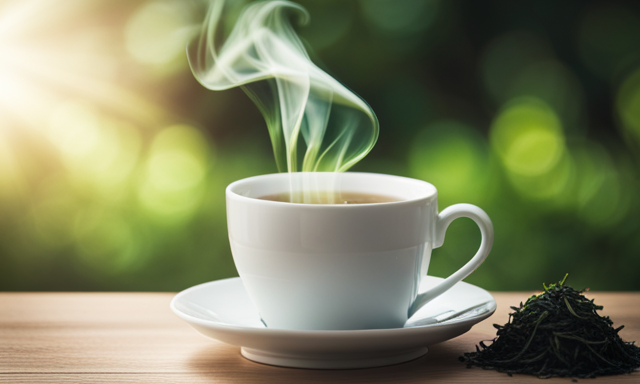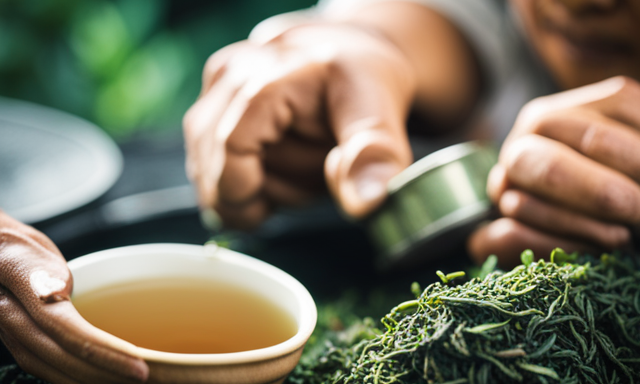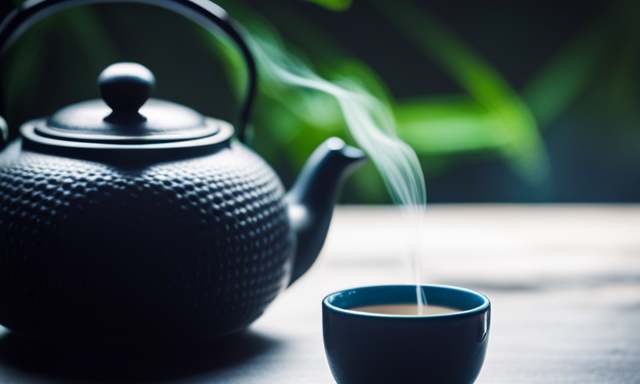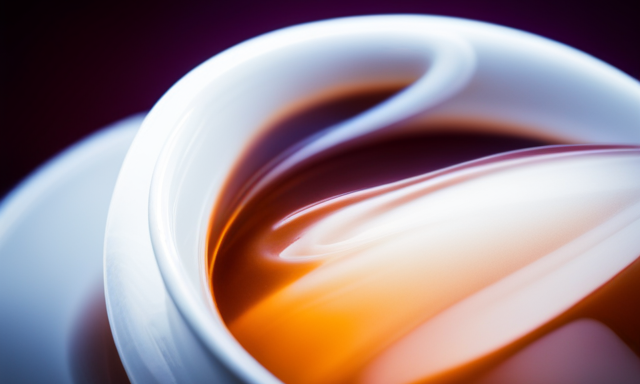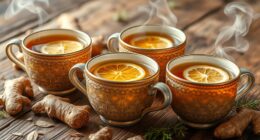As the saying goes, ‘Life is too short to drink bad tea.’ And when it comes to oolong tea, I couldn’t agree more. There is something truly captivating about this ancient Chinese tea that sets it apart from the rest.
With its delicate flavors and unique aromas, oolong tea offers a sensory experience like no other.
In this article, we will delve into the world of oolong tea and discover how to truly taste and appreciate its nuances. From understanding its origins to exploring the different varieties, we will leave no leaf unturned.
We will also discuss the proper techniques for preparing oolong tea, as well as how to assess its appearance, aroma, and flavor profile.
So, whether you’re a tea connoisseur looking to deepen your knowledge or a curious beginner eager to embark on a tea-tasting adventure, this article is for you. Get ready to savor each sip and unlock the secrets of oolong tea.
Key Takeaways
- Aftertaste reveals tea quality and craftsmanship.
- Each oolong tea variety has a unique aftertaste.
- Pairing oolong tea with food enhances flavors.
- Experimenting with food pairings enhances oolong tea flavors.
Understanding the Origins of Oolong Tea
Let’s delve into the fascinating origins of oolong tea and unravel the rich history behind this beloved beverage.
Oolong tea is a traditional Chinese tea that originated in the Fujian province. Its unique taste and aroma are a result of the intricate processing techniques employed. The leaves undergo partial oxidation, which gives oolong tea its characteristic flavor profile, balancing the freshness of green tea with the richness of black tea.
Besides its delightful taste, oolong tea is known for its numerous health benefits. It’s believed to aid digestion, boost metabolism, and promote weight loss. Additionally, oolong tea contains antioxidants that can help reduce the risk of chronic diseases.
Now, let’s explore the different varieties of oolong tea and discover their distinct characteristics.
Exploring the Different Varieties of Oolong Tea
Discovering the rich array of oolong tea varieties is like embarking on a captivating journey of flavors and aromas. Each variety offers a unique taste experience, making it a delight for tea enthusiasts. Here are three reasons why exploring the different varieties of oolong tea is an exciting endeavor:
-
Health Benefits: Oolong tea is known for its numerous health benefits. It boosts metabolism, aids in weight loss, promotes heart health, and improves cognitive function. Each variety of oolong tea brings its own set of wellness benefits.
-
Flavor Profiles: The flavor profiles of different oolong teas can vary widely. They can be light and floral or bold and roasted, catering to every palate. Some varieties may have fruity notes, while others may have a creamy or nutty taste. Exploring these diverse flavor profiles is a delightful experience for tea connoisseurs.
-
Aromas: The aroma of oolong tea can be equally enticing. Each variety has its own distinct fragrance that adds to the overall sensory experience. From the sweet scent of orchids to the earthy aroma of roasted leaves, the aromas of oolong tea are a treat for the senses.
With a newfound understanding of the different varieties of oolong tea, it’s time to delve into the next step: preparing oolong tea for tasting.
Preparing Oolong Tea for Tasting
Embarking on the journey of preparing oolong tea for a sensory exploration feels like unwrapping a delicate flower, slowly revealing its hidden layers of aroma and flavor.
To fully appreciate the complexity of oolong tea, it’s important to use proper preparing techniques. Start by heating water to around 190-200°F to ensure the tea leaves aren’t burnt.
Next, rinse the tea leaves briefly with hot water to awaken their flavors. Then, steep the leaves in hot water for about 3-5 minutes, allowing them to unfurl and release their essence.
For serving, oolong tea can be enjoyed plain or with a touch of honey or milk. The delicate floral and fruity notes of oolong tea pair well with light pastries or fresh fruits.
As we move into examining the aroma of oolong tea, we begin to unravel its true essence.
Examining the Aroma of Oolong Tea
As we delve into the fragrance of oolong tea, a sensory journey unfolds, revealing a symphony of delicate and captivating scents. When examining the aroma, it’s essential to identify the fragrance notes present in the tea. Here are three key characteristics to look for:
-
Floral notes: Oolong teas often exhibit floral aromas, ranging from subtle hints of orchid and jasmine to more robust scents like rose or magnolia. Take a moment to appreciate the floral nuances that dance gracefully in each sip.
-
Fruity undertones: Some oolong teas boast fruity aromas, such as peach, apple, or citrus. These fruity notes add a refreshing and invigorating element to the overall olfactory experience.
-
Toasted or nutty accents: Oolong teas can also offer roasted or nutty fragrances, reminiscent of roasted grains or almonds. These aromas bring depth and warmth to the tea, providing a comforting and satisfying sensation.
By examining the aroma, we lay the foundation for our next step: noting the appearance and color of the tea leaves.
Noting the Appearance and Color of the Tea Leaves
Take a moment to observe the visual beauty of the tea leaves and their vibrant colors, allowing yourself to appreciate the artistry in each cup.
Noting the texture and mouthfeel of oolong tea is an essential part of experiencing its full sensory delight. The appearance of the tea leaves can give you valuable insights into the quality and craftsmanship of the tea. Look for tightly rolled leaves that unfurl gracefully when brewed, indicating a well-processed oolong tea.
The color of the leaves can vary from green to brown, depending on the level of oxidation. This color spectrum gives you a clue about the tea’s flavor profile.
Analyzing the brewing techniques for oolong tea, such as steeping time and water temperature, also contributes to the overall taste experience.
Appreciating the first sip: tasting the initial flavors reveals the true essence of oolong tea and its complexity.
Appreciating the First Sip: Tasting the Initial Flavors
Savoring that first sip of oolong tea is like discovering a hidden treasure trove of flavors that’ll make your taste buds do a happy dance. To truly appreciate the initial flavors, it’s important to use proper tasting techniques.
Start by taking a small sip and allowing the tea to coat your palate. Pay attention to the flavor profiles that emerge. Oolong teas can have a wide range of flavors, from floral and fruity to nutty and toasty. The taste may evolve as you hold the tea in your mouth, revealing different layers of complexity.
The first sip sets the stage for the rest of the tea experience, giving you a glimpse into the tea’s character and potential. As you savor the flavors, you’ll find yourself eagerly anticipating the next step: assessing the mouthfeel and texture of oolong tea.
Assessing the Mouthfeel and Texture of Oolong Tea
Indulge in the velvety smoothness and delicate texture that caress your palate with each sip of oolong, leaving you in awe of its luxurious mouthfeel. When assessing the mouthfeel of oolong tea, it’s essential to pay attention to its texture. Here are five key elements to evaluate:
-
Creaminess: Oolong tea often boasts a creamy mouthfeel, creating a luscious sensation that coats your tongue.
-
Thickness: Notice the thickness of the tea as it glides over your taste buds, giving a sense of substance.
-
Astringency: Oolong tea can exhibit a slight astringency, leaving a pleasant dryness on the tongue.
-
Smoothness: Assess how smoothly the tea flows, without any rough or harsh sensations.
-
Lingering sensation: Observe the lasting impression the tea leaves in your mouth, whether it’s a refreshing or lingering sensation.
As we delve into the subsequent section about noticing the aftertaste and lingering flavors, we’ll explore the final aspect of fully appreciating oolong tea.
Noticing the Aftertaste and Lingering Flavors
Experience the enchanting dance of flavors that lingers on your palate, leaving a tantalizing aftertaste that you won’t soon forget. When sipping oolong tea, it’s essential to pay attention to the aftertaste, as it reveals much about the tea’s quality and craftsmanship.
Noticing the aftertaste involves taking a moment to let the flavors settle and identifying the lingering sensations that remain in your mouth. Is it sweet and floral, with hints of orchid and honey? Or perhaps it’s more earthy and nutty, with a subtle roasted undertone?
Each oolong tea variety will have its unique aftertaste, and by paying attention, you can truly appreciate the tea’s complexity.
As we move into the next section about pairing oolong tea with food for a complete experience, let’s explore how these lingering flavors can enhance your culinary journey.
Pairing Oolong Tea with Food for a Complete Experience
Discover the perfect culinary companions that complement the rich flavors of oolong tea, elevating your gastronomic journey to new heights. Pairing oolong tea with food enhances its flavors and creates a complete sensory experience.
Here are three food items that perfectly complement oolong tea:
-
Fresh fruits: The natural sweetness and juiciness of fruits like peaches, apples, and berries harmonize with the floral and fruity notes of oolong tea, creating a refreshing and delightful combination.
-
Nuts and cheeses: The earthy and nutty flavors of roasted almonds, cashews, or aged cheeses like Gouda or Roquefort provide a contrasting taste that balances the floral and sweet notes of oolong tea, resulting in a harmonious blend.
-
Seafood and sushi: Oolong tea’s delicate and complex flavors pair exceptionally well with seafood dishes like shrimp, lobster, or sushi. The tea’s subtle floral and vegetal undertones complement the oceanic flavors, creating a truly remarkable taste experience.
By experimenting with different food pairings, you can enhance the flavors of oolong tea and create a truly memorable culinary adventure.
Frequently Asked Questions
Can oolong tea help with weight loss?
Oolong tea has been shown to have weight loss benefits due to its ability to increase metabolism. Drinking oolong tea regularly can aid in weight management by boosting calorie burning and promoting fat breakdown.
What is the caffeine content in oolong tea?
Oolong tea has a moderate amount of caffeine, making it a great choice for a pick-me-up. Compared to other tea varieties, oolong falls in the middle range. Additionally, oolong tea offers numerous health benefits.
How long should I steep oolong tea for the best flavor?
For the best flavor, steeping oolong tea requires the right brewing techniques. The optimal steeping time for oolong tea is typically around 3-5 minutes, but it may vary depending on personal preference and the specific oolong tea variety.
Can I drink oolong tea if I have a sensitive stomach?
Drinking oolong tea on an empty stomach can be a mixed bag. While it’s generally gentle on the stomach, it can trigger acid reflux in some individuals. It’s best to listen to your body and consume it in moderation.
Is oolong tea suitable for people with diabetes?
Oolong tea is suitable for people with diabetes as it has been shown to have potential benefits for diabetes management. It can help regulate blood sugar levels and improve insulin sensitivity, making it a good choice for diabetic patients.
Conclusion
Well, folks, if you’ve made it this far, then congratulations! You’ve just become an expert on how to taste oolong tea. Now, armed with your newfound knowledge, you can embark on a journey of tea tasting like no other.
From understanding the origins of oolong tea to appreciating its aroma, appearance, and flavors, you’ve got it all covered. So, grab your favorite tea cup, sit back, and savor the delightful experience of oolong tea.
And hey, don’t forget to pair it with some delicious food for the ultimate tea-tasting extravaganza! Cheers!


